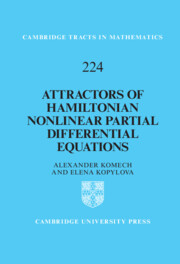Book contents
- Frontmatter
- Dedication
- Contents
- Preface
- Introduction
- 1 Global Attraction to Stationary States
- 2 Global Attraction to Solitons
- 3 Global Attraction to Stationary Orbits
- 4 Asymptotic Stability of Stationary Orbits and Solitons
- 5 Adiabatic Effective Dynamics of Solitons
- 6 Numerical Simulation of Solitons
- 7 Dispersive Decay
- 8 Attractors and Quantum Mechanics
- Bibliography
- Index
Introduction
Published online by Cambridge University Press: 17 September 2021
- Frontmatter
- Dedication
- Contents
- Preface
- Introduction
- 1 Global Attraction to Stationary States
- 2 Global Attraction to Solitons
- 3 Global Attraction to Stationary Orbits
- 4 Asymptotic Stability of Stationary Orbits and Solitons
- 5 Adiabatic Effective Dynamics of Solitons
- 6 Numerical Simulation of Solitons
- 7 Dispersive Decay
- 8 Attractors and Quantum Mechanics
- Bibliography
- Index
Summary
We list the main works on long-term behavior of solutions and attractors for nonlinear dissipative partial differential equations, beginning with the seminal work of L. Landau in 1944. We recall the main stages in the emergence of scattering theory fornonlinear Hamiltonian partial differential equations and formulate a general conjectureon the global attractors for such equations,invariant with respect to some Lie group. Furthermore, we listthe main results presented in this monograph: (1) the results onglobal attraction to stationary states in the case of a trivial symmetry group, to solitons in the case of the translation group, and to stationary orbits in the case of unitary and rotation groups; (2)the results on asymptotic stability of solitons and their effective adiabatic dynamics in weak external fields; (3) the results on numerical simulation of global attraction to solitons; and (4) the results on dispersive decay. In conclusion, we comment on the connection between the theory of attractors and quantum mechanics and the theory of elementary particles.
Keywords
- Type
- Chapter
- Information
- Publisher: Cambridge University PressPrint publication year: 2021

